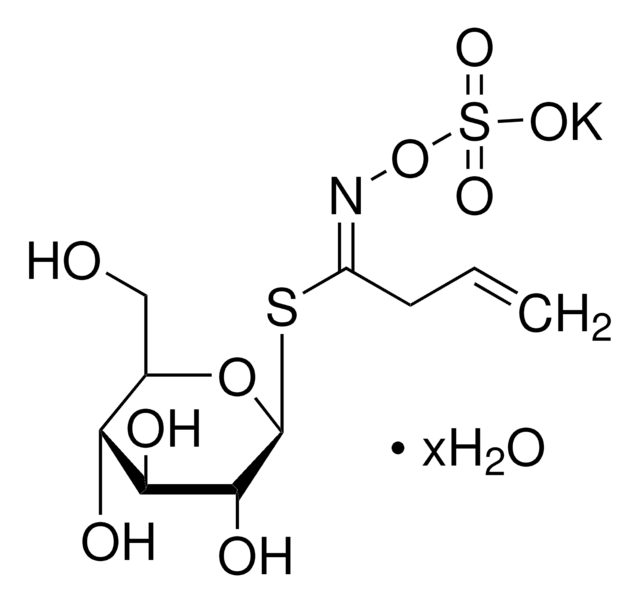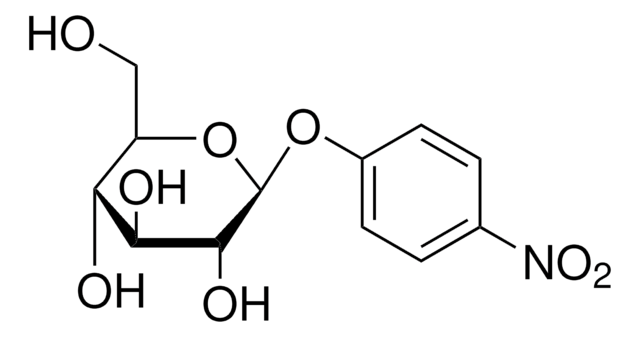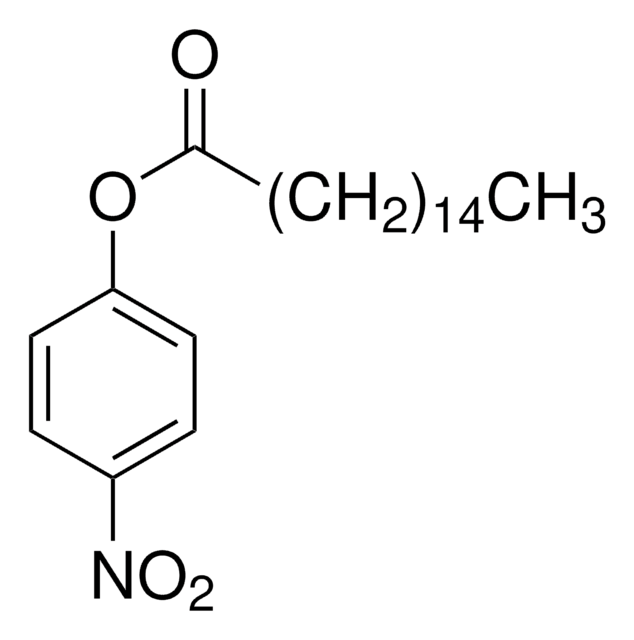1048
4-Nitrophenol
spectrophotometric grade
Sinonimo/i:
p-Nitrophenol
About This Item
Prodotti consigliati
Grado
spectrophotometric grade
Livello qualitativo
Tensione di vapore
0.6 mmHg ( 120 °C)
Stato
powder
Temp. autoaccensione
541 °F
tecniche
UV/Vis spectroscopy: suitable
P. ebollizione
279 °C (lit.)
Punto di fusione
110-115 °C (lit.)
Solubilità
ethanol: 95%, clear, dark yellow (100 mg/mL)
Stringa SMILE
O=N(C1=CC=C(O)C=C1)=O
InChI
1S/C6H5NO3/c8-6-3-1-5(2-4-6)7(9)10/h1-4,8H
BTJIUGUIPKRLHP-UHFFFAOYSA-N
Informazioni sul gene
human ... UGT1A4(54657)
Cerchi prodotti simili? Visita Guida al confronto tra prodotti
Applicazioni
- Spectroscopic monitoring of polyurethane-based nanocomposite as a potential catalyst for the reduction of dyes.: This research explores the use of a polyurethane-based nanocomposite incorporating 4-Nitrophenol for spectroscopic monitoring and catalysis. The study demonstrates its effectiveness in reducing dye concentrations, providing a valuable tool for environmental cleanup and chemical processing industries (Alam K et al., 2024).
- Silica@poly(chitosan-N-isopropylacrylamide-methacrylic acid) microgels: Extraction of palladium (II) ions and in situ formation of palladium nanoparticles for pollutant reduction.: Discusses the synthesis and application of innovative microgels that utilize 4-Nitrophenol in processes for extracting palladium ions and reducing pollutants. This highlights its utility in heavy metal remediation and nanoparticle synthesis, relevant for environmental and materials science (Alzahrani AYA et al., 2024).
- Reaction mechanisms of chlorinated disinfection byproducts formed from nitrophenol compounds with different structures during chlor(am)ination and UV/post-chlor(am)ination.: Examines how 4-Nitrophenol and similar compounds react under different water treatment processes, providing insights into the formation and control of disinfection byproducts. This is crucial for improving water treatment safety and effectiveness (Prasad Singh R et al., 2024).
- Comprehensive Studies of Adsorption Equilibrium and Kinetics for Selected Aromatic Organic Compounds on Activated Carbon.: This study provides a detailed analysis of 4-Nitrophenol adsorption on activated carbon, offering valuable data on its behavior in water treatment systems. The findings are critical for designing more efficient adsorption processes to remove contaminants from water (Marczewski AW et al., 2024).
Avvertenze
Warning
Indicazioni di pericolo
Consigli di prudenza
Classi di pericolo
Acute Tox. 4 Dermal - Acute Tox. 4 Inhalation - Acute Tox. 4 Oral - STOT RE 2 Oral
Organi bersaglio
Kidney,Liver
Codice della classe di stoccaggio
6.1C - Combustible acute toxic Cat.3 / toxic compounds or compounds which causing chronic effects
Classe di pericolosità dell'acqua (WGK)
WGK 2
Punto d’infiammabilità (°F)
336.2 °F - closed cup
Punto d’infiammabilità (°C)
169.0 °C - closed cup
Dispositivi di protezione individuale
dust mask type N95 (US), Eyeshields, Faceshields, Gloves
Scegli una delle versioni più recenti:
Possiedi già questo prodotto?
I documenti relativi ai prodotti acquistati recentemente sono disponibili nell’Archivio dei documenti.
I clienti hanno visto anche
Il team dei nostri ricercatori vanta grande esperienza in tutte le aree della ricerca quali Life Science, scienza dei materiali, sintesi chimica, cromatografia, discipline analitiche, ecc..
Contatta l'Assistenza Tecnica.








